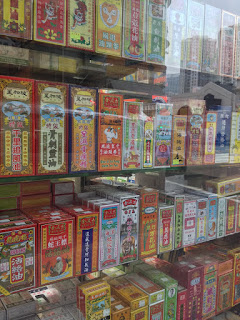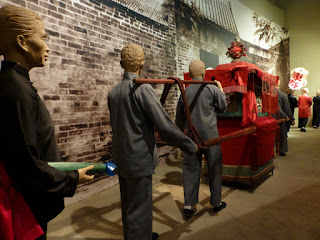There are two Hong Kongs. I may sound like a broken record, but the contrast is amazing. Walking downtown among the shiny new skyscrapers and big money, Hong Kong is that international commerce city everyone pictures it to be.
But cross the water and Kowloon is packed, grimy, and dirty. As I've said before, though, Kowloon is where Hong Kong's real soul is, so with that in mind I set out along Shanghai Street from Kowloon Park all the way up to the Mong Kok area and even further to Boundary Street.If Hong Kong Island is downtown Manhattan, Kowloon is Queens, Brooklyn, or Harlem. But worse.
The low-rise skyscrapers with tiny apartments go on forever, and there isn't a tree in sight. But it is a lively street with lots of shops on the ground floor.
As the evening goes on, it even holds a couple markets.
Walking here, you're going to see lots of everyday shops, but they're worth peeking in. There are occasional food shops, but restaurants and such are few and far between. There are a couple areas where you'll find clusters of windows selling snacks.
Many of the shops in the area are markets, but Chinese markets aren't the same as the supermarkets you find in America. The food may be staples here, but it's all exotic to me.
Shops in Hong Kong tend to specialize. The same is true in Japan, where entire neighborhoods seem to be packed with shops all selling the same thing. Shanghai Street is known as a cook's paradise, with tons of cookware to go with the markets.
I don't know what those boxes are on the right, but they're really cool.
Of course, looking up shows more of the grimy, AC unit-pockmarked low rises housing dozens of families each.
Shanghai Street is also known for the signage. Apparently the government has been trying to remove some or all of them, but at night it adds even more character. Closer to Mong Kok, Shanghai Street used to have lots of sex trade industries (massage parlors, host/hostess clubs, etc), and the signage frequently is for those businesses which remain. In fact, there's a small outdoor sex toy market (a dozen vendors or so) every night on nearby Temple Street.
With a mix of neighborhood life, interesting shopping, some history, and even a few museums, Shanghai Street turned out to be a great place to get a feel for the colorful Hong Kong.
It's probably possible to spend a whole day strolling from one end to the other, checking out the shops and the few heritage buildings, and visiting the museums. But you will want to stay in the area until evening, when the night markets are set up. I didn't get to any of the museums nor do any shopping, but I made sure to visit the Ladies Market (relatively) nearby in the afternoon, returning back to the Temple Street Market after the sun went down.
The southern end of the street is at Kowloon Park (closest MTR: Jordan Station), not far from the ferry terminal, reaching up 2.3 kilometers to Lai Chi Kok Road near Prince Edward MTR Station.














































































